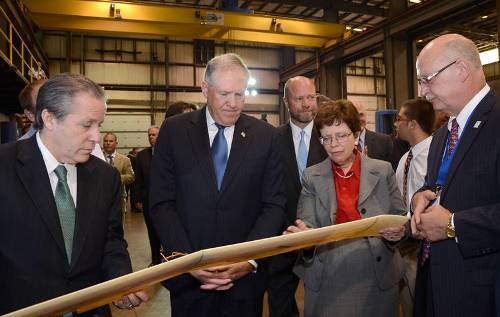Aurora Flight Sciences' three-dimensional (3D) wing was exhibited at the announcement of the new National Additive Manufacturing Innovation Institute (NAMII) on August 16, 2012, in Youngstown, Ohio.
 From left, Gene Sperling (Director of the National Economic Council and Assistant to the President ); Frank Kendall (Under Secretary of Defense for Acquisition, Technology and Logistics); Brett Lambert (Deputy Assistant Secretary of Defense Manufacturing and Industrial Base Policy); Rebecca Blank (Acting Secretary of Commerce); and Ralph Resnick (President and Executive Director of NCDMM) hold Aurora's 3D wing developed with Stratasys. (photo credit: Bruce W. Palmer)
From left, Gene Sperling (Director of the National Economic Council and Assistant to the President ); Frank Kendall (Under Secretary of Defense for Acquisition, Technology and Logistics); Brett Lambert (Deputy Assistant Secretary of Defense Manufacturing and Industrial Base Policy); Rebecca Blank (Acting Secretary of Commerce); and Ralph Resnick (President and Executive Director of NCDMM) hold Aurora's 3D wing developed with Stratasys. (photo credit: Bruce W. Palmer)
Frank Kendall, Under Secretary of Defense for Acquisition and Technology, together with Gene Sperling, Director of the National Economic Council and Assistant to the President for Economic Policy, and Rebecca Blank, Acting Secretary of Commerce made the announcement. United States Congressman Tim Ryan of Ohio and United States Senator Sherrod Brown also participated in the event.
Aurora Flight Sciences together with Stratasys created and flew a 62" wingspan aircraft featuring a wing made completely of additive manufactured components. Aurora designed the wing and Stratasys fabricated the component using its Fused Deposition Modeling (FDM) 3D printers.
The Stratasys FDM printer utilized a 3D design model for the fabrication of Aurora's wing which involved the deposition of layers of superior-performance thermoplastic material. This production technique decreases certain design constraints faced by engineers when they utilize conventional fabrication techniques. The Stratasys FDM printer delivers unprecedented capabilities to rapidly prototype tiny aerospace structures.
The innovative design of the wing decreases its weight but retains its strength. Aurora and Stratasys will continue their collaboration for further development of additive manufacturing for applications in the aerospace industry.
Aurora’s Structures Research Engineer, Dan Campbell stated that the success of this wing has demonstrated that 3D printing is capable of manufacturing the structure of a tiny airplane. Replacement of a wing can be done by fabricating a new wing within a couple of days by simply clicking ‘print.’
Stratasys’ Application Development Lead, Bill Macy stated that in the aerospace industry, additive manufacturing provides advantages such as reduction in material consumption, elimination of tooling, reduction in part count, and simplified assembly. These advantages enable the fabrication of products at reduced quantity, time and cost but with competitive performance.